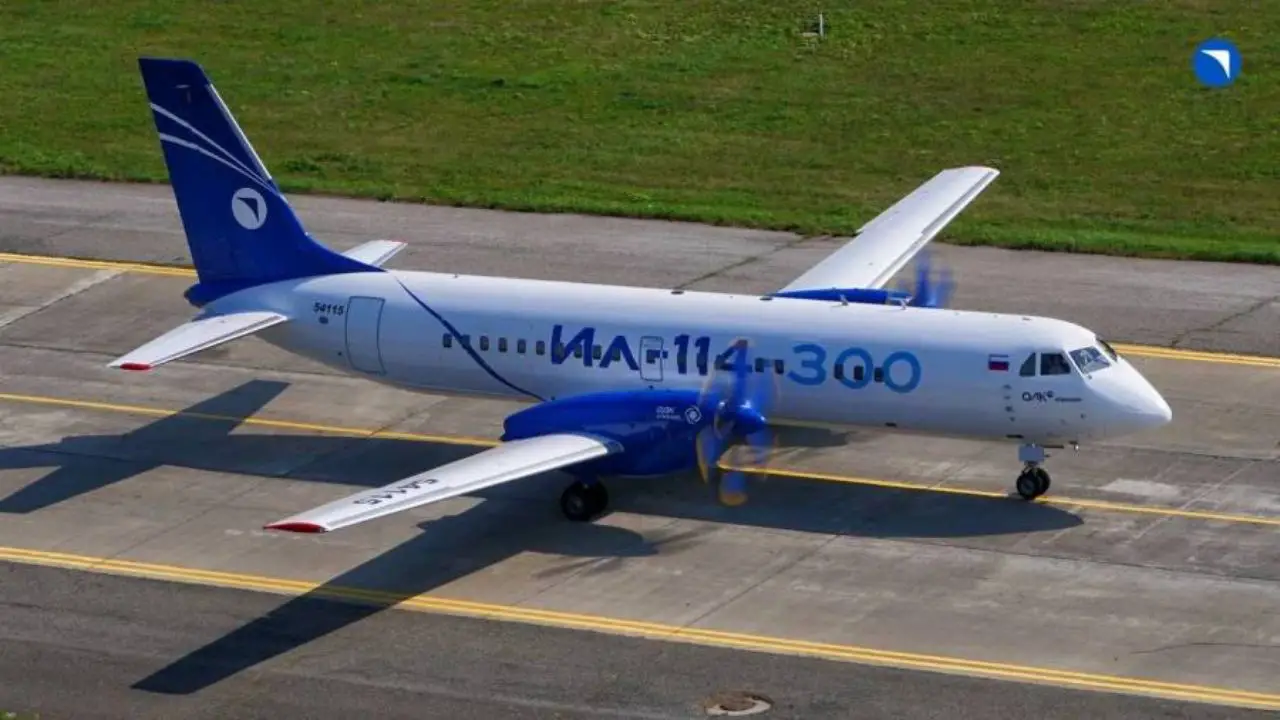The Ilyushin Company has reported significant progress in the development and production of its new regional airliner, the Il-114-300. The aircraft’s design is intended to accommodate regional routes, and it is expected to provide many improvements in efficiency and performance.
Modernization and Production Timeline
Ilyushin intends to deliver the first three Il-114-300 aircraft as early as October 2026, according to the most recent updates. The company will be able to manufacture a maximum of twelve aircraft annually starting in 2027. In addition to production, ongoing modernization initiatives are designed to further improve the aircraft’s capabilities and features.
Enhanced Performance and Range
A reduction in the aircraft’s weight is one of the major improvements anticipated by 2028. This will extend its maximum flight range from the current 1,000 kilometers to 1,450 kilometers, even when operating with a full complement of 66 passengers. The Il-114-300 will be able to carry out continuous flights on routes such as Khabarovsk to Okhotsk, which stretch a distance of 1,360 kilometers, as a result of this extended range.
Runway Requirements
The Il-114-300 will require runways with a hard surface that are at least 1,400 meters long. Until 2027 or 2028, the aircraft will not be used on unpaved runways. In the Khabarovsk region, only four airfields currently meet these requirements: Khabarovsk, Nikolaevsk-on-Amur, Sovetskaya Gavan, and Bogorodskoye.
Fuel Efficiency and Certification
The Il-114-300’s fuel efficiency is a significant advantage. The aircraft is expected to burn 16% less fuel than the European ATR 72-600, rendering it a cost-effective option for airlines. After the flight tests are concluded, the aircraft’s ultimate performance characteristics will be verified, and certification is anticipated to occur by the conclusion of 2025.
ATR versus Il
The ATR 72-600 is a regional turboprop aircraft that is frequently used and is known for its operational reliability and fuel efficiency. Its typical cruise fuel consumption is approximately 650 kg per hour, as per manufacturer data. However, some operational reports indicate that the consumption may vary between 650 and 800 kg per hour, depending upon altitude and flight conditions. It is one of the most cost-effective aircraft in its class for short-haul itineraries, with a fuel efficiency of approximately 1.41 kg per kilometer when operating with a full passenger load.
In contrast, the Il-114-300, which is soon to be released by Ilyushin, is touted as a direct competitor to the ATR 72-600. Its main selling point is its 16% lower fuel consumption. This would result in an estimated cruise fuel consumption of approximately 546 kg per hour for the Il-114-300, a substantial decrease that could potentially lead to reduced operating costs for airlines and enhanced environmental performance. In addition, the Il-114-300 is undergoing modernization to improve its efficiency and range. It is anticipated that the flight range will be increased from 1,000 to 1,450 kilometers when the aircraft is fully loaded with 66 passengers.
The Il-114-300’s lower fuel consumption may provide a competitive advantage, particularly as airlines endeavor to reduce costs and emissions, despite the fact that both aircraft are intended for short-haul regional operations. The ATR 72-600 continues to be a popular choice due to its established support network and proven reliability, while the Il-114-300 is designed to attract operators with its ongoing modernization efforts and enhanced efficiency.
The ATR 72-600 and the Ilyushin Il-114-300 are both modern regional turboprop aircraft that are intended for short-haul itineraries. However, they differ in many respects, including passenger capacity and cabin amenities.
The ATR 72-600 is designed to accommodate up to 78 passengers in a high-density configuration; however, the majority of airlines prefer 72 seats with a standard 29-inch pitch for improved comfort. The cabin stands out by its modern interior design, which includes plentiful seating and amenities that are intended to improve the convenience of passengers, including advanced lighting and noise reduction capabilities. Typically, passengers board the aircraft through the rear door, which facilitates a smooth movement of passengers. Additionally, the aircraft’s design facilitates rapid turnarounds, which are crucial for regional operations. The ATR 72-600 is also commended for its adaptability to a diverse array of airports, including those with limited or unpaved runways, which makes it an ideal choice for airlines that serve remote communities.
The latest configuration of the Il-114-300 typically accommodates 68 passengers, although some sources indicate that earlier versions had a capacity of 64 seats. The aircraft is engineered to withstand challenging conditions, including rough fields and short runways, which are common in Russia’s remote regions, and its compartment is designed for regional comfort. Despite the fact that the Il-114-300 has a slightly lower passenger capacity than the ATR 72-600, it is designed to provide high reliability and reduced operating costs in environments where infrastructure may be lacking. The Il-114-300 also boasts a simplified design with reduced maintenance requirements, which may prove advantageous for operators in less developed regions.
In conclusion, the ATR 72-600 is an ideal choice for airlines that prioritize passenger amenities and swift turnaround, as it provides a cabin that prioritizes comfort and efficiency and slightly increases the passenger capacity. The Il-114-300 prioritizes operational flexibility and cost-effectiveness, particularly in challenging or remote regions, despite its reduced passenger capacity.
Official Website of Youtube Channel – Altitude Addicts
